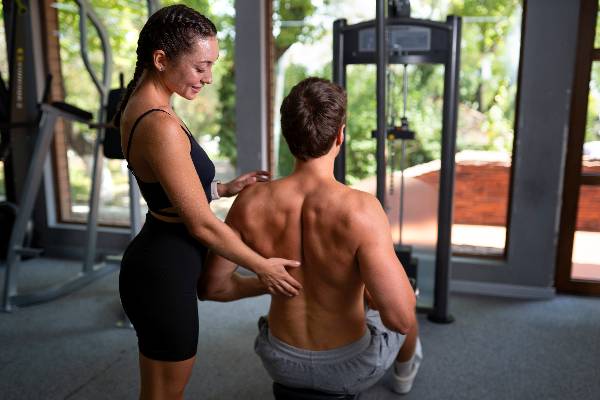Back Workout Using Your Own Bodyweight
Introduction: The Benefits of Bodyweight Workouts
Bodyweight workouts have surged in popularity, and for good reason. They offer a flexible and effective way to build strength without the need for a gym or expensive equipment. When it comes to targeting your back, using your own bodyweight can be incredibly beneficial. A strong back not only enhances your posture but also supports overall functional movement, making daily activities easier and injury less likely.
Imagine sculpting those muscles with exercises that challenge you while utilizing just your body weight. No fancy machines or weights needed—just you and gravity working together. Ready to dive into an energizing back workout? Let’s unlock the power of bodyweight exercises!
Warm-Up: Preparing Your Body for a Back Workout
Before diving into your back workout using your own bodyweight, it’s essential to warm up. A proper warm-up primes your muscles and joints for the exercises ahead. It increases blood flow and enhances flexibility.
Start with dynamic stretches, targeting the upper body and core. Arm circles and torso twists can be particularly effective in loosening tight muscles.
Incorporating light cardio is also beneficial. Jumping jacks or jogging in place for a few minutes gets your heart rate up, preparing your entire body for action.
Remember to engage those key back muscles during this phase. Simple movements like shoulder shrugs or scapular retractions activate the lats and traps, setting you up for success as you progress into more intense exercises. Focusing on mobility ensures that you’re not only ready but safe while performing each movement effectively throughout your workout session.
Exercises:
When it comes to a back workout using your own bodyweight, there are several effective exercises you can incorporate.
Start with pull-ups. They target various muscles in your back and arms. Find a sturdy bar, grip it firmly, and pull yourself up until your chin surpasses the bar’s height.
Next on the list is inverted rows. Position yourself under a low bar or table. With an overhand grip, pull your chest towards the surface while keeping your body straight.
The superman hold is another fantastic option for strengthening lower back muscles. Lie face down on the floor and raise both arms and legs simultaneously while holding that position for several seconds.
Plank with arm raises adds stability work into the mix. From a plank position, lift one arm forward while keeping your balance steady—then switch sides.
Incorporating these movements will effectively challenge and build strength in your back without any equipment necessary.
– Pull-Ups
Pull-ups are a powerhouse exercise for building back strength. They engage multiple muscles, especially the latissimus dorsi, which gives your back that V-shape.
To perform a pull-up, grip the bar with palms facing away from you. Hang freely with arms extended and feet off the ground. Pull yourself up until your chin surpasses the bar, then lower down slowly.
One of the great aspects of pull-ups is their versatility. You can adjust your grip width or try different variations like chin-ups to target different areas of your back and biceps.
If you’re new to this move, consider starting with assisted pull-ups or negative reps. These modifications help build strength gradually while maintaining proper form and technique. Keep practicing; consistency is key!
– Inverted Rows
Inverted rows are a fantastic addition to any back workout using your own bodyweight. This exercise targets the upper and middle back, along with engaging your core.
To perform an inverted row, find a sturdy bar or low-hanging surface. Position yourself under it, grasping the bar with an overhand grip. Your body should form a straight line from head to heels.
Pull your chest towards the bar while keeping your elbows close to your sides. Squeeze those shoulder blades together at the top of the movement for maximum effect. Lower yourself slowly and repeat.
What makes inverted rows so versatile is that you can adjust their difficulty by changing your angle. The more horizontal you are, the harder it gets! It’s perfect for beginners or advanced athletes looking to improve strength without heavy equipment.
– Superman Hold
The Superman Hold is a fantastic exercise for building strength in your back, glutes, and core. It mimics the iconic superhero pose while engaging multiple muscle groups.
To perform this move, lie face down on the floor with your arms extended above your head. Keep your legs straight and together. As you inhale, lift both your arms and legs off the ground simultaneously. Imagine trying to fly like Superman!
Focus on squeezing your shoulder blades together as you hold this position. Aim to maintain proper alignment; avoid straining your neck by keeping it neutral.
Start with 20-30 seconds and gradually increase as you grow stronger. This simple yet effective move can be incorporated into any bodyweight routine for an extra challenge that targets essential muscles in the back area.
– Plank with Arm Raise
The plank with arm raise is a powerful bodyweight exercise that engages multiple muscle groups simultaneously. This move not only targets your back but also strengthens your core, shoulders, and glutes.
Start in a traditional plank position. Keep your body straight from head to heels. Engage your core for stability.
Now, slowly lift one arm forward while maintaining balance. Aim for controlled movements; avoid swaying or twisting the hips.
Hold the arm up for a moment before lowering it back down and switching sides. Focus on breathing steadily throughout the motion.
Incorporating this exercise into your routine enhances stability and coordination. It challenges both strength and balance effectively, making it an efficient choice for any workout focused on building upper body strength without weights.
Creating a Routine: How Many Sets and Reps?
When designing a back workout using your own bodyweight, the number of sets and reps can make a significant difference. For beginners, starting with 2-3 sets of each exercise is ideal. This allows for proper form while building strength.
Aim for 8-12 repetitions per set for exercises like pull-ups and inverted rows. This rep range helps stimulate muscle growth effectively without overexerting yourself too soon.
As you progress, consider increasing to 4 sets or adding more challenging variations. Listening to your body is key; if you feel fatigued before completing the reps, it’s perfectly fine to scale back.
Rest between sets should be around 30 seconds to one minute. This will keep your muscles engaged while allowing brief recovery time for optimal performance in your subsequent sets. Adjusting these parameters as needed will help you establish a routine that promotes continuous improvement in strength and endurance.
Tips for Proper Form and Technique
Maintaining proper form during your back workout is crucial for effectiveness and injury prevention. Start by engaging your core. A solid core stabilizes your body and supports the spine.
For pull-ups, grip the bar firmly without straining your shoulders. Keep your elbows slightly bent as you pull yourself up to avoid unnecessary stress on the joints.
During inverted rows, ensure that your body remains in a straight line from head to heels. Avoid sagging or arching at the hips; this engages more muscles effectively.
When performing the superman hold, lift both arms and legs simultaneously while keeping them extended but relaxed. Hold for a few seconds before lowering gently.
In plank with an arm raise, keep hips level and don’t twist as you lift each arm. This helps maintain balance while targeting those back muscles efficiently.
Advancing Your Workout: Adding Resistance or Variations
Once you’ve mastered bodyweight exercises, it’s time to level up. Adding resistance can significantly enhance your back workout using your own bodyweight.
Consider incorporating a weighted vest or backpack filled with books. This extra weight challenges your muscles further and promotes strength gains.
You can also explore variations of the basic exercises. For instance, try wide-grip pull-ups to target different areas of your back, or elevate your feet during inverted rows for increased difficulty.
Another effective method is adjusting tempo. Slow down each repetition to increase tension on the muscles, helping build endurance and strength simultaneously.
Don’t hesitate to mix in explosive movements like clapping pull-ups if you’re feeling adventurous. These variations not only keep workouts fresh but also engage stabilizing muscles that often get overlooked.
Conclusion: The Importance of a Strong Back and Why Bodyweight Workouts
A strong back is essential for overall health and functionality. It supports your posture, enables proper movement, and reduces the risk of injuries. Neglecting back strength can lead to discomfort and long-term issues.
Bodyweight workouts are a fantastic way to build that strength without needing expensive equipment or a gym membership. They require minimal space and can be done anywhere, making them accessible for everyone.
Incorporating bodyweight exercises into your routine not only enhances muscle tone but also improves coordination and stability. The versatility of these workouts allows you to tailor them to your fitness level while progressively challenging yourself as you advance.
Remember, the key is consistency. With regular practice, you’ll notice significant improvements in your back strength, which will positively impact other areas of your life too. Embrace bodyweight training as part of your fitness journey—your back will thank you!
- About the Author
- Latest Posts
Johnnie D. Jackow Sr., the founder and CEO of Total Body Fitness, Worldwide, has a long-standing career in the fitness industry. He began as a certified personal trainer in the mid-90s and soon after authored his first weight loss book in 1998. This led to the launch of Total Body Fitness, Nationwide in the USA at the same time. Johnnie gained recognition as the fitness guru of his time, running infomercials on local TV late at night in Houston, Texas. Over the years, he has helped more than 40,000 individuals from all over the world achieve their health and fitness goals. With over 60,000 hours of documented training in integrative functional medicine, he completed his PhD in human physiology in 2010. His primary objective is to assist people in reaching their health and fitness goals through alternative approaches rather than relying solely on conventional medicine and pharmaceutical drugs. Today, with almost three decades of experience under his belt, Johnnie continues to be a leader in health and fitness.








